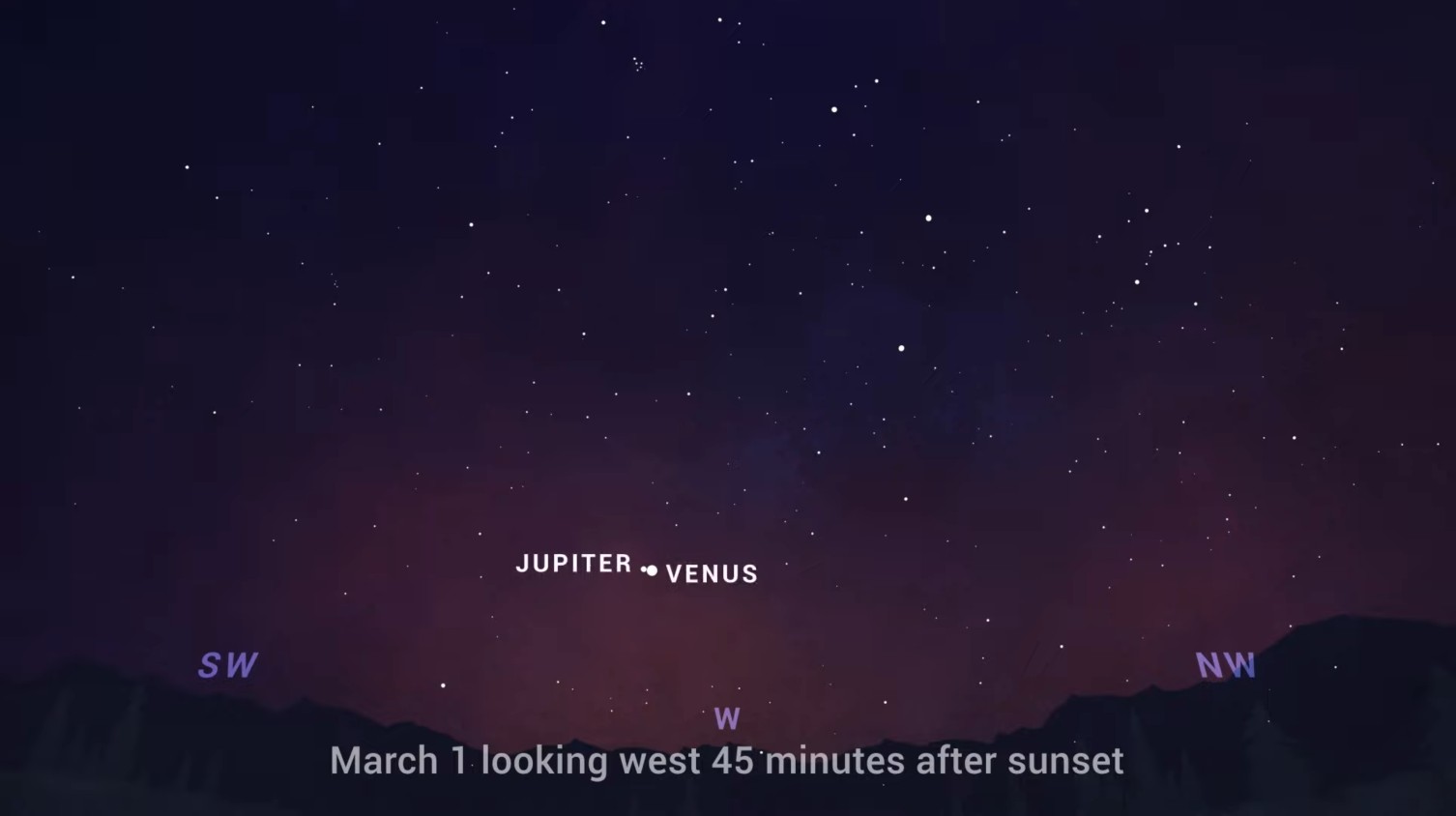Venus and Jupiter get so close they nearly 'kiss' in the night sky tonight. Here's how to see it.
The two bright planets will put on quite a show.

Venus and Jupiter will approach each other in the night sky on Wednesday (March 1) during a meeting of solar system record breakers, the hottest planet and the largest.
During the close approach between the two planets, Venus and Jupiter will pass within just 29.4 arcminutes, or about half a degree, of each other, according to In the Sky. They're so close, the two planets will appear to "kiss" in the night sky. (Your clenched fist held at arm's length covers about 10 degrees of sky.)
From New York City, the pairing will appear at about 6:04 p.m. EST (2304 GMT), when the two planets are around 23 degrees over the horizon to the west. Venus and Jupiter will then sink toward the horizon and will set around 2.5 hours after the sun. The moment of closest approach will occur at 12:05 a.m. EST (0505 GMT) on Thursday (March 2).
Related: The 12 best night sky events to see in 2023

Want a telescope to see bright planets? We recommend the Celestron Astro Fi 102 as the top pick in our best beginner's telescope guide.
During the close approach, both planets will be in the constellation of Pisces. Venus will have a magnitude of -4.0, while Jupiter will have a magnitude of -2.1, with the minus prefix before both magnitudes indicating particularly bright objects over Earth.
"They will be close enough to fit within the field of view of a telescope, but will also be visible to the naked eye or through a pair of binoculars," In the Sky wrote.
The second planet from the sun, Venus is also the solar system’s hottest world. Venus is hotter than Mercury, the closest planet to the sun, because it possesses a thick atmosphere that traps heat and causes an extreme runaway greenhouse effect.
Get the Space.com Newsletter
Breaking space news, the latest updates on rocket launches, skywatching events and more!
Surface temperatures on Venus get as hot as around 900 degrees Fahrenheit (475 degrees Celsius), which is sufficient to melt lead. The planet is also punctuated with volcanoes, some of which may still be active. Volcanic activity, if it is ongoing, may be helping to drive up temperatures by choking the atmosphere with greenhouse gases.
Jupiter is much farther out in the solar system — it's the fifth planet from the sun — and is therefore much cooler than Venus, with an average temperature of around minus 238 degrees Fahrenheit (minus 150 degrees Celsius).
While it loses the temperature contest, Jupiter can’t be challenged in terms of size. The massive gas giant has a diameter of around 88,846 miles (142,984 kilometers), while Venus' diameter is just 7,520 miles (12,103 km). You could fit around 1,400 Venuses inside the gas giant.
This massive size difference means that, while Venus is much closer to Earth than Jupiter, the gas giant will still have a larger angular size in the night sky on Wednesday compared to the second planet from the sun. Jupiter will have an angular size of around 33"3, while the angular size of Venus will be 12"2.
If you’re hoping to catch a glimpse of Venus and Jupiter during the close encounter, our guides for the best telescopes and best binoculars are a great place to start.
If you’re looking to snap photos of the night sky, check out our guide on how to photograph the moon, as well as our best cameras for astrophotography and best lenses for astrophotography.
Editor’s Note: If you snap a photo of the close approach of Venus and Jupiter and would like to share it with Space.com’s readers, send your image(s), comments, and your name and location to spacephotos@space.com.
Follow us on Twitter @Spacedotcom or Facebook.
Join our Space Forums to keep talking space on the latest missions, night sky and more! And if you have a news tip, correction or comment, let us know at: community@space.com.

Robert Lea is a science journalist in the U.K. whose articles have been published in Physics World, New Scientist, Astronomy Magazine, All About Space, Newsweek and ZME Science. He also writes about science communication for Elsevier and the European Journal of Physics. Rob holds a bachelor of science degree in physics and astronomy from the U.K.’s Open University. Follow him on Twitter @sciencef1rst.









